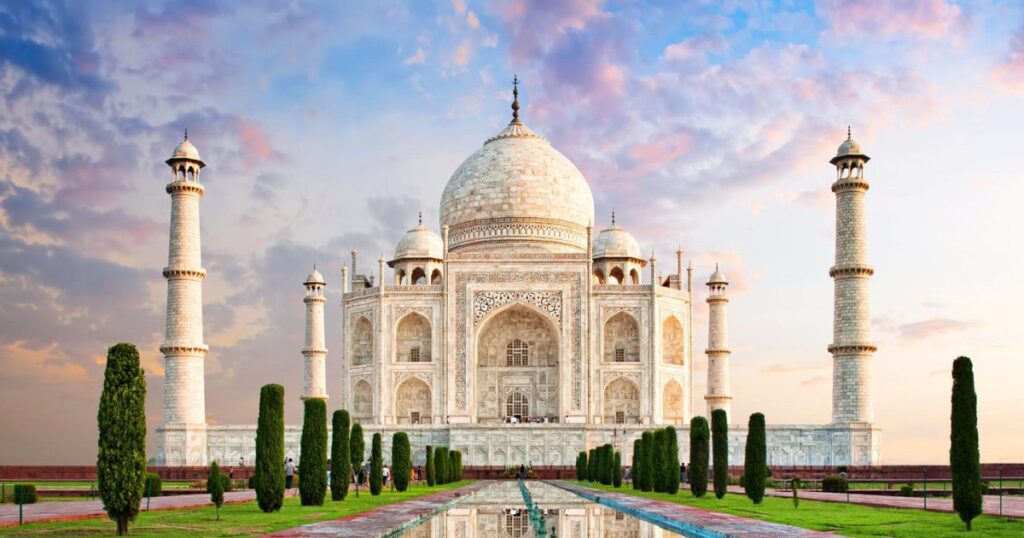The Taj Mahal, India's iconic monument of love, attracts millions of visitors each year. This UNESCO World Heritage site in Agra stands as a testament to eternal love and exemplary Mughal architecture. While its beauty is captivating year-round, experiencing the majestic white marble mausoleum without battling through crowds can transform your visit from hectic to magical.
Finding the best time to visit Taj Mahal to avoid crowd requires strategic planning based on seasons, days of the week, and even specific hours. With the right approach, you can experience this architectural marvel in relative tranquility, allowing for perfect photographs and moments of quiet contemplation in one of the world's most beautiful buildings.
The Taj Mahal was built by Emperor Shah Jahan in memory of his beloved wife Mumtaz Mahal, with construction spanning approximately 22 years from 1632 to 1653. This architectural masterpiece combines elements of Persian, Islamic, and Indian architectural styles, featuring perfect symmetry, intricate marble inlay work (pietra dura), and magnificent gardens designed according to Islamic paradise garden concepts.
Table of Contents
Best Time to Visit Taj Mahal: Quick Guide
The weather in Agra varies dramatically throughout the year, significantly affecting visitor numbers and your overall experience at the Taj Mahal. Understanding these seasonal patterns will help you determine the best time to visit Taj Mahal based on your comfort preferences and crowd tolerance.
Each season offers distinct advantages and challenges, from weather conditions to tourist density. While peak tourist seasons offer more reliable weather, they also bring larger crowds. Conversely, off-peak periods may offer more solitude but might require enduring less ideal climate conditions.
| Day of Week | Crowd Level | Best Time to Visit | Notes |
| Monday | Moderate | Early morning | Good weekday option with manageable crowds |
| Tuesday | Low | All day | One of the best weekdays for a peaceful visit |
| Wednesday | Low | All day | Excellent choice with minimal tour groups |
| Thursday | Moderate-High | Early morning only | Busy due to Friday closure preparation |
| Friday | CLOSED | Garden areas only | Main mausoleum closed for prayers |
| Saturday | Very High | Avoid if possible | First day after closure, extremely crowded |
| Sunday | High | Sunrise only | Weekend crowds, early morning essential |
Taj Mahal in Morning: Early Bird Advantage

Experiencing the Taj Mahal at sunrise offers perhaps the most magical and crowd-free opportunity to appreciate this architectural wonder. The early morning light casts a gentle glow on the white marble, creating a photographer's paradise and a peaceful atmosphere rarely found during regular visiting hours.
Arriving at the Taj Mahal in morning provides several distinct advantages that make the early wake-up call worthwhile. This timing strategy is widely considered the single most effective approach for those seeking the best time to visit Taj Mahal to avoid crowd.
Sunrise Magic at the Taj Mahal
The sunrise experience offers unique benefits that cannot be replicated at any other time of day:
- First entry tickets allow access before standard opening hours
- Soft, golden light creates stunning photographic opportunities
- Temperature remains cool and comfortable, even in summer months
- Significantly fewer visitors, particularly tour groups
- Peaceful atmosphere allowing for contemplative appreciation
To maximize the sunrise advantage, arrive at the ticket counter at least 30 minutes before sunrise. During winter months, be prepared for potential morning fog, which usually dissipates by 9-10 AM, often creating magical, ethereal views as it lifts.
Morning vs. Afternoon vs. Evening
Different times of day offer distinctly different experiences at the Taj Mahal:
- Morning (6:00 AM - 10:00 AM): Least crowded, best lighting for photographs, comfortable temperatures
- Midday (10:00 AM - 2:00 PM): Highest tourist concentration, harsh lighting, warmest temperatures
- Afternoon (2:00 PM - 5:00 PM): Gradually decreasing crowds, improving light quality
- Evening/Sunset: Beautiful golden hour lighting, moderate crowds, comfortable temperatures
While sunrise offers the optimal experience, late afternoon (approximately 3:00 PM onward) provides a good alternative as many tour groups depart for lunch around this time, and the lighting improves as sunset approaches.
Weekday vs. Weekend Dynamics
Beyond the Friday closure, general weekday and weekend patterns influence crowd levels:
- Monday through Thursday generally sees fewer domestic tourists than weekends
- Saturday and Sunday experience the highest overall visitor numbers
- National holidays in India dramatically increase domestic tourism
- School vacation periods (May-June) increase family visitors
- Early weekday mornings (Monday-Thursday) offer the least crowded experience overall
For the optimal combination of timing factors, consider visiting on a Tuesday or Wednesday morning at opening time during the shoulder seasons of September-October or February-March for the best balance of good weather and minimal crowds.
How Much Time to See Taj Mahal: Planning Your Visit
First-time visitors often wonder how much time it takes to see Taj Mahal properly. While the monument can technically be "seen" in minutes, truly appreciating its architectural details, historical significance, and perfect proportions requires thoughtful allocation of time.
Understanding how long most visitors spend helps in planning both your Taj Mahal visit and any other Agra attractions you wish to see on the same day. With strategic timing, you can experience the Taj without rushing while still exploring other significant sites in the area.
Comprehensive Taj Mahal Experience
For a complete and unhurried visit, allocate time as follows:
- Entry procedures and security checks: 15-30 minutes (varies with crowd levels)
- Main mausoleum exterior and surroundings: 1-1.5 hours
- Interior chamber viewing: 15-30 minutes (often with queuing time)
- Garden exploration and reflection pools: 30-45 minutes
- Museum exhibits near the western gate: 30 minutes (optional)
Most visitors find that 2-3 hours provides a satisfying experience without rushing. Photography enthusiasts and history buffs may wish to allocate additional time to capture different lighting perspectives or absorb historical details provided by guides.
Ticket Information
Understanding the ticketing system and entry procedures helps maximize your time at the monument rather than waiting in lines. The Taj Mahal uses a tiered pricing system with different fees for domestic and international visitors.
Ticket Categories and Pricing
The Taj Mahal offers several ticket options:
- Standard entry ticket: ₹1,100 for foreign tourists, ₹50 for Indian nationals
- Additional fee for main mausoleum entry: ₹200 (sometimes suspended during peak season)
- Premium ticket for sunrise/sunset viewing: Additional ₹200 (limited availability)
- Children under 15 years: Free entry
- SAARC and BIMSTEC countries citizens: ₹540
All tickets include shoe covers for entering the main mausoleum and a small bottle of water. Higher-priced foreign tourist tickets typically come with shorter queues, making the premium worthwhile during busy periods.
Hiring a Photographer / Tour Guide
- Hire a local photographer to capture stunning shots during sunrise or sunset.
- A licensed tour guide can share history, Mughal stories, and hidden details.
- Guides help navigate crowds and find the best photo spots.
- Adds a richer and more memorable experience beyond just sightseeing.
Also you can check out our blog about the Best Time to Visit Mount Abu With Family so that it can help you find Best Time to Spend on your next trip.
Best Time to Visit Taj Mahal to Avoid Crowd : Itinerary
When planning a day in Agra, it's worth considering how to combine your Taj Mahal visit with other significant attractions. With strategic timing, you can experience multiple historical sites while avoiding the worst crowds at each location.
Here are well-tested itinerary combinations that maximize your time in Agra:
Classic Full-Day Itinerary:
- 6:00 AM - 9:00 AM → Taj Mahal at sunrise
- 9:00 AM - 10:00 AM → Breakfast break
- 10:30 AM - 12:30 PM → Agra Fort
- 1:00 PM - 3:30 PM → Lunch
- 4:00 PM - 6:00 PM → Mehtab Bagh for sunset Taj views
For those with limited time in Agra, the most efficient combination is a sunrise visit to the Taj Mahal followed immediately by Agra Fort, allowing you to experience both UNESCO World Heritage sites before noon. For comprehensive cultural experiences that include multiple destinations in northern India, Varanasi-Ayodhya tour packages from Mumbai often include Agra and the Taj Mahal as part of their thoughtfully designed itineraries.
What to Wear at Taj Mahal
Choosing appropriate attire for your Taj Mahal visit affects both your comfort and experience. What to wear at Taj Mahal depends on the season, cultural considerations, and practical factors like extensive walking and photography opportunities.
Beyond comfort, thoughtful clothing choices can enhance your photographs, provide necessary protection from the elements, and demonstrate cultural sensitivity at this religiously significant site. With some strategic planning, your wardrobe choices can significantly improve your overall experience.
Seasonal Clothing Recommendations
Dress according to the season for maximum comfort:
- Winter (October-March): Light layers including a jacket or shawl for morning visits; comfortable walking shoes
- Summer (April-June): Lightweight, breathable fabrics; wide-brimmed hats; sunglasses; comfortable sandals with back straps
- Monsoon (July-September): Quick-drying fabrics; waterproof footwear; small umbrella or rain jacket
- Year-round essentials: Sunscreen, sunglasses, and a hat regardless of season
- For sunrise visits: Extra layer that can be removed as temperatures rise
What You Can and Cannot Bring Inside
- Allowed: small bags, mobile phones, cameras, and water bottles.
- Not Allowed: tripods, drones, tobacco, food items, chargers, headphones, large bags.
- Carry only essential items to avoid delays at security checks.
- Following the rules ensures a smooth and hassle-free visit.
During winter mornings, temperatures can be surprisingly chilly before sunrise, so a light jacket or shawl is recommended, particularly if arriving for opening time. These can easily be removed and carried as the day warms up.
Beyond the Taj: Exploring Agra
- Visit the Agra Fort, a UNESCO World Heritage Site showcasing Mughal architecture.
- Explore Mehtab Bagh for a picture-perfect view of the Taj Mahal across the Yamuna.
- Take a short trip to Fatehpur Sikri (40 km away) for more Mughal heritage.
- Relish local specialties like Agra’s famous petha and Mughlai cuisine.
Conclusion:
The Taj Mahal remains one of the world's most extraordinary architectural achievements, deserving of its place among the new Seven Wonders of the World. By strategically planning your visit during the best time to visit Taj Mahal to avoid crowd, you can experience this magnificent monument in relative tranquility.
Whether you choose the magical light of sunrise, the reduced crowds of monsoon season, or the comfortable temperatures of winter mornings, each approach offers distinct advantages. The key to an exceptional experience lies in thoughtful planning around the seasonal patterns, weekly cycles, and daily rhythms that influence visitor numbers.

Frenzy Holidays ensures a smooth and enriching travel experience from start to finish. You can visit us at Haware Centurion, S07/34, Nerul East, Sector 19A, Nerul, Navi Mumbai, Maharashtra 400706. For bookings or more information, call +91 7400453140, email [email protected], or visit www.frenzyholidays.com. So pack up and explore INDIA with frenzy holidays to have an unforgettable journey.
Best Time to Visit Taj Mahal to Avoid Crowd: FAQs
What is absolutely the best time to visit Taj Mahal to avoid crowd?
The earliest morning entry (at sunrise) on weekdays (Tuesday-Thursday) during the shoulder seasons (September-October or February-March) offers the optimal combination of good weather and minimal crowds. Arriving 30 minutes before opening time ensures you'll be among the first visitors.
Is it worth visiting the Taj Mahal during monsoon season?
Yes, the monsoon season (July-September) can offer a uniquely peaceful experience with dramatically reduced crowds and lush gardens. Rain typically comes in short bursts rather than all day, and the cloudy skies can create dramatic photography opportunities. Hotel rates are also at their lowest during this period.
How much time should I allocate for a complete Taj Mahal visit?
Most visitors find that 2-3 hours provides a satisfying experience without rushing. This allows time for security procedures, exploring the main mausoleum, gardens, and museums, plus taking photographs. Photography enthusiasts and history buffs may wish to allocate 3-4 hours.
What is the significance of Friday as a Taj Mahal off day?
The Taj Mahal closes to tourists every Friday for prayers as it contains an active mosque. This creates distinctive crowd patterns, with Thursdays and Saturdays typically seeing higher visitor numbers. The gardens remain accessible on Fridays, offering exterior views.
What should I wear for a comfortable visit to the Taj Mahal?
Dress modestly with comfortable walking shoes. In summer (April-June), wear lightweight, breathable fabrics and sun protection. In winter (October-March), bring light layers for cool mornings. During monsoon (July-September), quick-drying fabrics and waterproof footwear are advisable. Covering shoulders and knees is recommended year-round.
sunrise or sunset which is best time to visit Taj Mahal to avoid crowd ?
Sunrise typically offers the least crowded experience with beautiful soft lighting. Sunset provides golden hour photography opportunities but with more crowds. For photography, sunrise is generally superior as the main façade faces east and catches the morning light perfectly.
Are there any special full moon viewing opportunities at the Taj Mahal?
Yes, the Taj Mahal offers special night viewing during five days around the full moon (two days before, the full moon night, and two days after). These tickets are limited and must be purchased in advance. This experience provides a uniquely magical perspective of the monument under moonlight.
Which entrance gate is best for avoiding long lines?
The Eastern Gate is recommended for sunrise visits, while the Southern Gate typically has shorter lines during regular hours. The Western Gate, used by most tour groups, generally experiences the longest queues throughout the day.
How can I photograph the Taj Mahal without crowds in my pictures?
Visit at sunrise and head directly to the Diana Bench (the famous bench where Princess Diana was photographed). Alternatively, use creative angles from the gardens, particularly from the sides of the main walkway. For completely unobstructed views, consider visiting Mehtab Bagh across the river during late afternoon.
What are the best time to visit Taj Mahal to avoid crowd And also balanced weather ?
September-October and February-March offer the best balance of pleasant weather and moderate crowd levels. These shoulder seasons avoid both extreme temperatures and peak international tourism periods while still providing clear skies ideal for photography.

